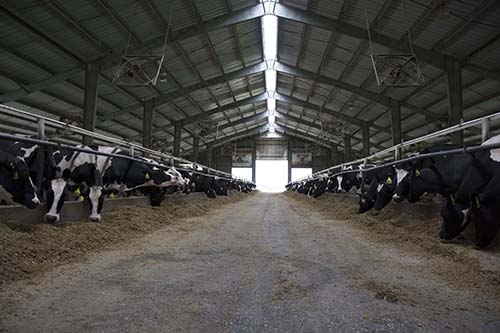
"There are four things every person, and every cow, needs," explained the Penn State University agricultural engineer. Those four components are ventilation (air), water, feed, and a resting area.
"Dairy farm design and management need to excel at all of these things," he said. "Production is held back by the weakest link."
Ventilation
Barns can be equipped with either natural or mechanical ventilation. Tyson explained that an advantage of natural ventilation is lower capital and operational costs. A disadvantage is a higher aggravation cost since you can't control the weather.
Mechanical ventilation could utilize either a positive or negative pressure system. Whatever direction you choose, "We have to build a ventilation system that can deal with a huge range of environments," Tyson said.
He also noted that heat stress abatement is a necessity of modern dairy housing. "No shelter can sustain maximum production in summer conditions without it," he said.
Water
Tyson reminded the audience that water is the largest feed ingredient on the farm, and that milk is 87 percent water. He explained that cows make components, but they don't make water. That means water must be consumed.
"The more milk we want out of a cow, the more water she has to drink," he stated.
Feed
"The modern dairy farm is trying to feed a satisfied cow," Tyson said. Beyond a well-balanced ration, Tyson briefly mentioned access to feed and matching animals' behavioral needs. For example, cows naturally eat with their heads down. Ideally, a feedbunk would allow this, keeping the feeding surface 2 to 6 inches above the front feet.
Feed access that enhances intake is extremely valuable. "One more kilogram of dry matter intake is approximately 2 more kilograms of milk produced," he said.
Resting space
Tyson noted that a cow wants to spend 12 to 14 hours per day resting and in all, a cow spends about three-fourths of its day resting, eating, and drinking. The resting area must be clean, dry, and comfortable.
Many cows today live in freestall barns. Tyson explained, "Freestalls are a system of many components and are only as good as the worst component." A stall may be wide enough and long enough, with plenty of deep bedding, but if the neck rail is in the wrong place, the whole stall may not work properly. Tyson noted that managing the freestall, and in reality the entire barn, as a whole system is key.
"If I invest in the cow, she pays me back," he said.

The author is an associate editor and covers animal health, dairy housing and equipment, and nutrient management. She grew up on a dairy farm near Plymouth, Wis., and previously served as a University of Wisconsin agricultural extension agent. She received a master's degree from North Carolina State University and a bachelor's from University of Wisconsin-Madison.









